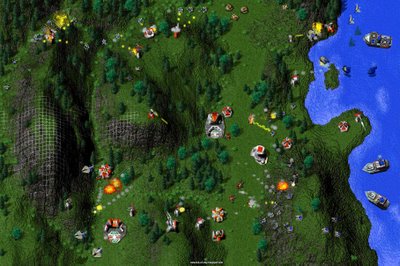 We didn't get our giant CG intro movie with dancing clones, but we still had to make all sorts of fancy pictures for marketing and the game. The universe I wanted to portray would still need a lot of high quality visuals to give players a decent sense of Total Annihilation's setting. We also needed plenty of promotional stuff for E3.
We didn't get our giant CG intro movie with dancing clones, but we still had to make all sorts of fancy pictures for marketing and the game. The universe I wanted to portray would still need a lot of high quality visuals to give players a decent sense of Total Annihilation's setting. We also needed plenty of promotional stuff for E3.For the game itself, we needed to make a short intro sequence, two victory sequences and a host of what we called mission paintings - The last items being a little visual reward shown to the player after successful completion of a level.
For the mission paintings I organized a simple assembly line. Every 4 or 5 models, the artists would make a "high res" version of a given unit. I put that in quotes since these only had 2,000 to 5,000 polygons. Models with higher poly counts are now common in real time environments. I think there are more polygons than that in Master Chief's left nostril.




These models were handed off to staff artist Jarrett Holderby. It turned out the same cheap, simple tools I chose for the game worked equally well for the mission paintings. Jarrett dropped these models into KPT Bryce, added some textures, rendered an image, then retouched the image in Photoshop and Painter.
It helped that Jarrett was a classically trained illustrator with a couple decades of experience. His eye for composition and lighting were (and are) superb. The Bryce scenes were devoid of grit, smoke, explosions, motion blur and other touches that help bring a futuristic war picture to life. Jarrett's ability to add these things "by hand" to a rendered images without making it too obvious was another rare gift. At top is an early image of Core Prime (a.k.a. Metal World). This setting was used for many pictures, but I don't think this particular image was ever used. I stole some of those textures when I made the metal world map segments.
All the renders for maps and mission paintings were done on Macs. Back artists had both a Mac and a Windows rig on their desks. An early rendition of Bryce existed for Windows, but it lacked the ability to export height maps bigger than 72 pixels on a side. We needed much bigger elevation maps for the background sections. We certainly needed huge height maps for these mission paintings. We mostly used Power Mac 8500's and 7600's. Opening or saving Jarrett's super big print files would take minutes. The same went for applying the simplest filter. The fact that Jarrett didn't go completely insane working on them is a real tribute to his fortitude.
This same technique provided most of the big, lush images we made for magazines and marketing. Jarrett assembled some truly fine scenes, all of which helped to build an image for the game and its universe.
 I think this image was made for a game magazine that never got off the ground. It would have been TA's only magazine cover prior to its launch, but that was not to be.
I think this image was made for a game magazine that never got off the ground. It would have been TA's only magazine cover prior to its launch, but that was not to be.The models from the unit artists were supplemented by additional pieces from the small team working on the movie sequences, giving Jarrett had a pretty decent inventory of models to work with. This added a lot to the scope and complexity of the pictures. Some images are more effective than others, but overall it was a great way to get a lot of pictures made in a small amount of time.
The movies represent another big push for the art team in the weeks leading up to E3 in 1997. More on that in the next TA-related post.
The movies represent another big push for the art team in the weeks leading up to E3 in 1997. More on that in the next TA-related post.
CK

















































